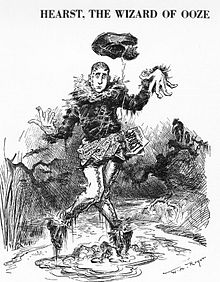
Political interpretations of The Wonderful Wizard of Oz include treatments of the modern fairy tale (written by L. Frank Baum and first published in 1900) as an allegory or metaphor for the political, economic, and social events of America in the 1890s. Scholars have examined four quite different versions of Oz: the novel of 1900,[1] the Broadway play of 1902,[2] the Hollywood film of 1939,[3] and the numerous follow-up Oz novels written after 1900 by Baum and others.[4]
The political interpretations focus on the first three, and emphasize the close relationship between the visual images and the story line to the political interests of the day. Biographers report that Baum had been a political activist in the 1890s with a special interest in the money question of gold and silver (bimetallism), and the illustrator William Wallace Denslow was a full-time editorial cartoonist for a major daily newspaper. For the 1902 Broadway production Baum inserted explicit references to prominent political characters such as then-president Theodore Roosevelt.
- ^ Ritter, Gretchen (August 1997). "Silver slippers and a golden cap: L. Frank Baum's The Wonderful Wizard of Oz and historical memory in American politics". Journal of American Studies. 31 (2): 171–203. doi:10.1017/s0021875897005628. JSTOR 27556260. S2CID 144369952.
- ^ Swartz, Mark Evan (2000). Oz Before the Rainbow: L. Frank Baum's "The Wonderful Wizard of Oz" on Stage and Screen to 1939. The Johns Hopkins University Press. ISBN 0-8018-6477-1.
- ^ Olson, James (2001). Historical Dictionary of the Great Depression, 1929–1940. Greenwood. pp. 315–316. ISBN 0-313-30618-4.
- ^ Hearn, Michael Patrick, ed. (2000). The Annotated Wizard of Oz. W. W. Norton & Company. ISBN 0-393-04992-2.